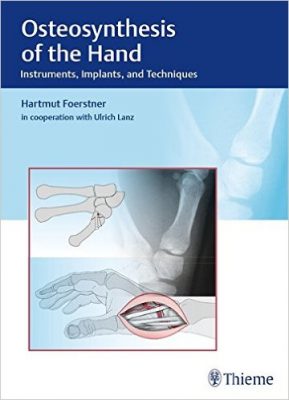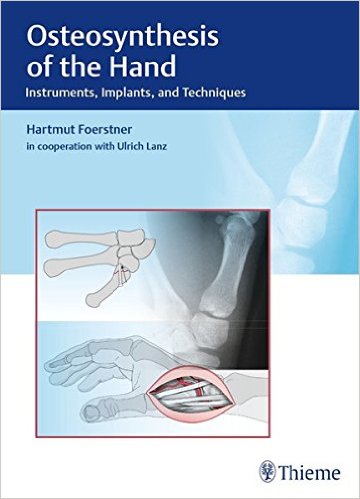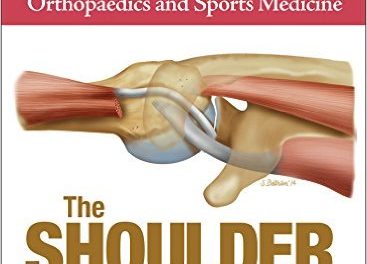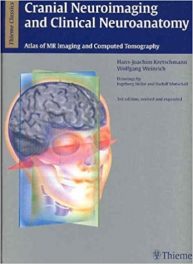 Author and Editor: Hartmut Foerstner, MD, with Ulrich Lanz
Author and Editor: Hartmut Foerstner, MD, with Ulrich Lanz
Publisher: Thieme – 188 pages, with 775 illustrations
Book Review by: Nano Khilnani
Osteosynthesis is the reduction and internal fixation of a bone fracture with implantable devices that are usually made of metal. It is a surgical procedure with an open or percutaneous approach to the fractured bone.
Early motion stability of the hand should be the postoperative goal when surgery is being considered, writes Dr. Foerstner in his Preface to this book. This should also be the goal of any decision not to operate.
He writes at the outset of this book: “Unimpaired hand function requires a stable bony framework. When fractures cause skeletal instability, this deficiency must be eliminated by targeted treatment, which may be surgical or nonoperative.”
So when there is a fracture on the hand, the surgeon needs to determine the most suitable treatment. The benefits and disadvantages of surgery must be evaluated carefully to answer the question of whether or not it is required to correct the problem.
“Conservative management, where hand fractures do not need internal fixation, has often proved effective,” Dr. Foerstner writes. “Surgical treatment should only be considered when it is clearly superior to conservative methods,” he adds.
With the above cautions in mind, there are nevertheless some fractures for which the best solution is ‘internal fixation’. These are some of them:
- Fractures for which closed reduction is not possible
- Fractures which run the risk of dislocating despite immobilization
- Open fractures with soft tissue injury
- Intra-articular fractures with nonreducible step-off
- Fractures that are unstable due to an articular chain
While fracture management constitutes a large part of this book, to provide you a broader view of what you will find in this book, we give you below the titles of its 11 chapters:
- Introduction
- Biology of Fracture Healing
- Nonoperative Fracture Management
- Surgical Fracture Management
- Differential Indication
- Principles of Surgical Management of Hand Fractures
- Postoperative Treatment
- Implants and Instruments
- Surgical Approaches
- Surgical Procedures
- Further Reading
While early motion stability is the ideal postoperative goal, Dr. Foerstner points out that that is not always possible: “The surgeon must sometimes accept a lesser degree of stability than early motion stability through adaptive osteosynthesis (Kirchner wire/adaptive screw fixation). Additional immobilization should be kept as small as possible or reversed by early, controlled therapy of the hand.” Transfixation with Kirschner wires is shown on pages 166-167.
This book is vastly different from most others in medicine in that it is primarily a visual presentation. With almost 775 images on 188 pages, that works out to an average of 4.12 images per page. So except for the Introduction, the other chapters consist mainly of images with captions.
Viewing pictures has been shown in numerous studies to be a very effective means of learning and retaining knowledge of ‘how-to-do’ tasks. With practice actually doing such tasks, our knowledge become broader and deeper.
What will you find in a typical chapter? Let’s take a look at chapter 4, Surgical Fracture Management, and provide you an outline of the topics covered in it.
- Surgical Fracture Management
4.1 Atraumatic Technique
4.1.1 The Ten Commandments of Atraumatic Surgery
4.2 Common Injuries, Consequences of Trauma, Deformities
4.2.1 Fractures f the Distal, Middle and Proximal Phalanges
4.2.2 Metacarpal Fractures
4.2.3 Fractures in Children
4.3 Indications for Surgery
4.4 Contraindications
It is important to read The Ten Commandments of Atraumatic Surgery as it provides practical dos and don’ts critical to successful surgical procedures.
This is an excellent text on osteosynthesis.
Author and Editor:
Hartmut Foerstner, MD is a surgeon specializing in general surgery, trauma surgery, and hand surgery based in Schramberg, Germany







